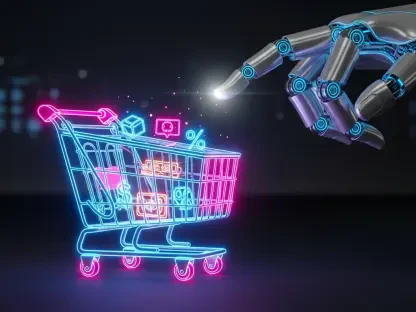The ever-evolving retail landscape requires businesses to stay ahead of the game, and Point of Sale (POS) retail system software is at the forefront of this transformation. As we move forward, the integration of POS systems in retail becomes non-negotiable, with these systems playing an essential role in enhancing transaction efficiency, inventory management, and customer interactions. This article delves into the dynamics of the POS retail system software market, focusing on its growth prospects, trends, and the challenges it encounters.
Technological Advancements Propelling Market Growth
Technological innovations have drastically transformed POS systems, which now play a pivotal role in modern retail operations. Enhanced features such as inventory management, customer analytics, and mobile payments have revolutionized how retailers manage their workflows. The introduction of AI and IoT into POS systems optimizes operational capabilities and boosts user experiences. These technologies empower retailers with real-time data, enabling them to make informed decisions swiftly and efficiently.
Another critical technological advancement is the increasing use of mobile POS systems. These systems provide retailers with the flexibility to conduct transactions anywhere within the store, improving the speed and efficiency of customer service. Additionally, advanced encryption and security features embedded in modern POS systems ensure that customer data is protected, which is paramount in building trust and compliance with regulatory standards.
Consumer Demand for Personalized Experiences
In today’s market, consumers are not just looking for products, but personalized shopping experiences. POS systems capable of handling diverse transactional platforms are becoming increasingly essential to meet these evolving demands. The trend towards secure and convenient payment solutions has accelerated, notably influenced by the lasting impacts of the COVID-19 pandemic. Consumers now expect businesses to offer seamless, contactless payment options, compelling retailers to adopt advanced and versatile POS solutions.
To retain customer loyalty and enhance the shopping experience, businesses must implement POS systems that integrate customer relationship management (CRM) tools. These integrations allow retailers to track customer preferences, purchase history, and feedback, thereby personalizing marketing campaigns and product recommendations. This alignment with consumer expectations not only improves customer satisfaction but also drives sales and revenue growth.
Regulatory Environment and Supportive Policies
Government policies and industry standards play a considerable role in shaping the POS retail system software market. Supportive regulations promoting sustainable solutions significantly contribute to market growth. Compliance with regulatory standards is crucial for building consumer trust and ensuring the secure processing of transactions. These regulatory frameworks compel businesses to adopt advanced POS systems that meet or exceed industry requirements.
Moreover, various governments have introduced initiatives and incentives to foster digital transformation within the retail sector. Grants and subsidies for adopting new technologies, including POS systems, make it easier for smaller businesses to invest in these advanced solutions. These supportive policies not only facilitate market expansion but also ensure that companies remain competitive in an increasingly digital economy.
E-commerce and Omnichannel Retailing
The surge of e-commerce and omnichannel retailing necessitates that retailers integrate offline and online sales channels seamlessly. Advanced POS systems are central to this integration, providing a consistent and efficient shopping experience across multiple platforms. Retailers are heavily investing in innovative POS solutions to manage their operations efficiently and cater to omnichannel shoppers. This integration is vital for driving market growth, as it allows businesses to meet consumer demands more effectively.
With the rise of omnichannel retailing, POS systems now need to offer functionalities such as inventory synchronization, real-time order tracking, and seamless returns processing across all sales channels. This not only improves operational efficiency but also enhances the customer experience by providing greater flexibility and convenience. Retailers that successfully implement these features are better positioned to thrive in a competitive market landscape.
Cloud-based Solutions: Flexibility and Scalability
The shift towards cloud-based POS systems marks a significant transformation in the retail landscape. These systems offer unparalleled scalability and flexibility, allowing retailers to access real-time data and insights from any location. Cloud-based solutions are particularly advantageous for small and medium-sized enterprises (SMEs), providing cost-effective ways to enhance their retail operations and profitability. This trend is significantly contributing to market expansion, as more businesses recognize the benefits of cloud technology.
Cloud-based POS systems also facilitate easier updates and maintenance, reducing the downtime typically associated with traditional systems. Retailers can quickly adapt to market changes and implement new features or updates without significant disruptions to their operations. The ability to scale resources according to demand ensures that businesses can handle peak shopping periods efficiently without compromising system performance.
Investment in Research and Development
Continuous investment in research and development by key industry players is fostering product innovation. This commitment to R&D is crucial for driving new offerings in the POS retail system software market. Companies that prioritize innovation and development are better equipped to respond to evolving market demands, opening up new opportunities and maintaining competitiveness. These investments also lead to the introduction of high-performance products that improve operational efficiency and customer satisfaction.
Research and development efforts often focus on creating integrated solutions that combine multiple retail operations into a single, cohesive system. These advancements can include features like advanced analytics, AI-driven sales forecasting, and automated inventory replenishment. By continuously improving and expanding their product offerings, companies can attract a broader customer base and drive long-term growth.
Challenges and Market Restraints
Despite the promising outlook, the POS retail system software market faces several challenges. High initial investment costs can be a significant deterrent for SMEs, hindering widespread adoption. Additionally, regulatory complexities and the need for stringent compliance add another layer of difficulty. Navigating these hurdles requires businesses to carefully plan their implementation strategies to ensure smooth market expansion and adoption.
Another restraint is the requirement for ongoing training and support. As POS systems become more advanced, it becomes essential for retailers to provide adequate training to their staff to fully leverage the system’s capabilities. This necessity can increase operational costs and time, which can be challenging for smaller businesses with limited resources.
Supply Chain Disruptions
The market’s growth is also susceptible to supply chain disruptions. Raw material shortages and logistical constraints can drive up costs and impede the implementation of POS systems. These disruptions highlight the importance of having a resilient supply chain strategy and taking proactive measures to mitigate potential hurdles in the retail sector.
Effective supply chain management is crucial in ensuring the timely delivery and maintenance of POS systems. Retailers must establish strong relationships with suppliers and develop contingency plans to address unexpected disruptions. This approach helps minimize the impact of supply chain challenges and ensures that businesses can continue to operate smoothly.
Market Saturation and Competitive Pressure
Developed regions often experience market saturation, making it imperative for businesses to explore emerging markets. Intense competition among key players puts pressure on profit margins, compelling companies to distinguish themselves through innovation and strategic alliances. In a saturated market environment, businesses need to continuously evolve and adapt to maintain a competitive edge.
Exploring new markets requires a thorough understanding of local consumer preferences and regulatory landscapes. Retailers must tailor their POS solutions to meet the specific needs of these markets, which can involve significant investment in localization and marketing efforts. Successful entry into emerging markets can provide substantial growth opportunities and help mitigate the effects of saturation in developed regions.
Economic Fluctuations and Geopolitical Instability
Economic conditions and geopolitical stability considerably affect market dynamics. Inflation, economic downturns, and geopolitical tensions contribute to market uncertainties. To navigate these external factors effectively, retailers must develop agile and adaptable business strategies that can withstand economic fluctuations and ensure sustained market growth.
Businesses can benefit from diversifying their operations and investing in markets with stable economic conditions. Additionally, staying informed about global events and trends can help companies anticipate potential challenges and implement proactive measures to safeguard their operations. Flexibility and resilience are key attributes for businesses aiming to thrive amid economic and geopolitical uncertainties.
Emerging Trends Shaping the Market
Integration of advanced digital technologies is transforming the POS retail system software landscape. Innovations such as AI, automation, and IoT are enhancing the performance and functionality of POS systems. These advancements provide retailers with capabilities to streamline their operations, improve customer experiences, and gain a competitive edge in the market.
The focus on sustainability is another significant trend. Retailers are increasingly adopting eco-friendly systems and practices, aligning with regulatory requirements and consumer preferences for sustainable solutions. Sustainable practices not only benefit the environment but also enhance a company’s market reputation and attract environmentally-conscious consumers.
Personalization and Customization
There is a growing shift towards personalized and customized POS solutions. Retailers are leveraging these advancements to cater to specific consumer needs and industry demands. This trend is reshaping market dynamics, encouraging companies to develop bespoke systems that offer unique functionalities tailored to their customers.
Customization can include tailored user interfaces, specialized reporting features, and integration with other business systems. By offering personalized solutions, retailers can improve operational efficiency, meet unique business requirements, and deliver a superior shopping experience to their customers. This approach drives customer loyalty and differentiates businesses in a competitive market.
Strategic Collaborations and Partnerships
Partnerships, mergers, and acquisitions are key strategies for expanding market reach and technological capabilities. These collaborative efforts foster innovation and strengthen competitive positions. Businesses are increasingly seeking strategic alliances to leverage shared expertise and resources, propelling market growth and enhancing service offerings.
Collaborative ventures can provide access to new technologies, markets, and customer bases, which can be instrumental in driving growth. Furthermore, strategic partnerships can lead to the development of integrated solutions that offer comprehensive functionalities, meeting the diverse needs of modern retailers. These alliances help companies stay ahead in a rapidly evolving market landscape.
Final Thoughts
In today’s rapidly changing retail landscape, businesses must stay ahead, and Point of Sale (POS) retail system software is crucial to this transformation. As we advance, integrating POS systems into retail operations is non-negotiable. These systems are integral in boosting transaction efficiency, managing inventory effectively, and improving customer interactions. This article examines the dynamics of the POS retail system software market, highlighting its growth prospects, emerging trends, and the challenges it faces.
POS systems have evolved from simple transaction processors to comprehensive tools that support various business functions. They now offer robust features such as real-time inventory tracking, sales analytics, and customer relationship management (CRM) capabilities. The shift towards cloud-based POS systems has also revolutionized the industry by providing more flexibility, scalability, and access to advanced features without substantial upfront investments.
However, the market faces challenges such as cybersecurity threats and the need for continuous upgrades to keep up with technological advancements. Despite these hurdles, the future for POS retail system software looks promising, with innovations poised to further streamline retail operations and enhance the customer shopping experience.
Retailers that adopt advanced POS systems will likely find themselves better equipped to handle the demands of the modern consumer, ensuring their place in an increasingly competitive market.









